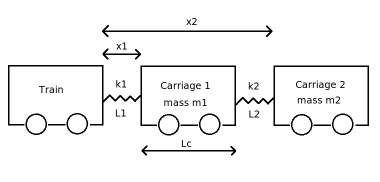Or search by topic
Number and algebra
Geometry and measure
Probability and statistics
Working mathematically
Advanced mathematics
For younger learners
Published 2010
Maths in the Undergraduate Physical Sciences
Are you planning to study engineering, physics or another course involving lots of applied mathematics at university?
In your first year you will undoubtedly take maths courses to bring you up to speed with many of the advanced mathematical techniques required in the serious applications of mathematics to the physical sciences.
Whilst courses and content do, of course, vary, there is a general core of content most physical scientists will encounter and make use of in their first year of study. Unfortunately, however, it is sometimes not immediately clear how the maths you are taught will be useful in the physical and practical applications.
This article lists some of the topics you are very likely to come across, and explains just some of the areas where they can be applied to physical science problems. The topics below also link to articles and problems where you can learn about them in more detail. The more familiar you are with these concepts and new vocabulary the smoother your transition to university should be. Good luck!
1. Vector manipulation
An important definition here is the cross product. This defines a vector ${\bf a} \times {\bf b}$ which is perpendicular to both ${\bf a}$ and ${\bf b}$, and has magnitude $\mid {\bf a} \mid \mid {\bf b} \mid \sin \theta$ . Suppose we have a spherical object which rotates about a fixed axis at a constant speed, such as the earth. Individual points on the surface will move at different speeds,
depending on whether they are closer to the pole or the equator. By using the cross product we can concisely define the speed at every point, it turns out it is given by $\Omega \times {\bf x}$, where $\Omega$ is the angular velocity of the earth and is a constant vector pointing along its axis, and ${\bf x}$ is the position vector from the centre of the earth to the point on the surface we're
interested in.
The cross product is crucial in the physical sciences when using Moments. Moments allow us to calculate how an object, pivoted at a certain point, will move when a force is exerted upon it. Consider pushing a door. If the (shortest) vector from the hinge axis to the place where the door is pushed is ${\bf r}$, and the force exerted is ${\bf F}$, then the moment is ${\bf r} \times {\bf F}$, and is
equal to the moment of inertia of the door (a property of the door) multiplied by the acceleration of the door around its axis, the hinge. This is a form of Newton's second law, Force = Mass x Acceleration. The further away from the hinge the door is pushed, the larger moment is exerted, and the faster the door moves.
New definitions and techniques:- Triple products, ${\bf a} \times {\bf b} \times {\bf c}$ and ${\bf a} \cdot {\bf b} \times {\bf c}$.
Vectors are useful for: Finding the shortest distance between two lines. Defining the Electromagnetic equations. And lots more.
Suggested NRICH problems: V-P Cycles; Flexi Quads; Flexi-Quad Tan
Further information - NRICH articles: Vectors - What Are They?; Multiplication of Vectors
2. Matrices

New definitions and techniques:- Eigenvectors and eigenvalues. Matrix multiplication. Inverse of a Matrix. Determinants.
Matrices are useful for: Physical systems with several degrees of freedom. Solving simultaneous equations. Writing mathematical expressions concisely.
Suggested NRICH problems: The Matrix; Fix Me or Crush Me; Transformations for 10
3. Complex numbers
4. Fourier Series
5. Differential equations
Differential equations are good for: Modelling physical systems.
Suggested NRICH problems: Differential Electricity; Euler's Buckling Formula; Ramping it Up
Related Collections
You may also like
Overarch 2
Bricks are 20cm long and 10cm high. How high could an arch be built without mortar on a flat horizontal surface, to overhang by 1 metre? How big an overhang is it possible to make like this?
Stonehenge
Explain why, when moving heavy objects on rollers, the object moves twice as fast as the rollers. Try a similar experiment yourself.
Maximum Flow
Given the graph of a supply network and the maximum capacity for flow in each section find the maximum flow across the network.

